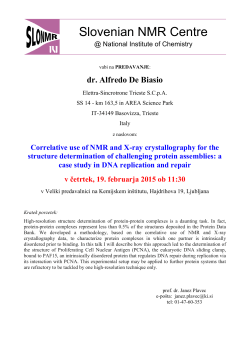
Problem of the Month: June 2012
Problem of the Month: May 2015 1 1 2 H,H COSY spectrum, signal intensities in blue (500 MHz, DMSO-d6) 1 11 22 2 6 1H chemical shifts: 7.75, 5.36, 4.51, 4.49, 3.70, 3.41, 3.30, 3.18, 3.16, 3.11, 1.55, 0.80 © NMR, University of Cologne, 2015 May 2015 Problem of the Month: May 2015 Strategy (1) On the previous page, an H,H correlation experiment is presented which allows to derive three spin systems that are coupled over two or three bonds, respectively. Note, that the spectrum was recorded in DMSO-d6. Thus, correlation can also be observed with so-called ‚exchanging‘ protons. (2) It is always useful to determine the number of DBE (i.e. degree of saturation) for the molecule, if the molecular formula is given: C9H19NO4. (3) H,C connectivities can be assigned from the correlation experiment shown on the next page. As one can note, there are diastereotopic protons. Protons which are not bound to a carbon show no cross peak. Also, to facilitate assignment, cross peaks in red represent CH or CH3 carbons, while blue peaks signify CH2 groups. Problem of the Month: May 2015 1 2 12 1 2 33 H,C HMQC (section), optimized for JHC of 145 Hz (500/125 MHz) 13C chemical shifts: 173.4, 75.6, 68.5, 59.1, 39.5, 35.9, 32.8, 21.4, 20.9 © NMR, University of Cologne, 2015 May 2015 Problem of the Month: May 2015 Hints (1) Quarternary carbon centers are printed in black in the 13C chemical shift list. Take a look at the four chemical shifts that appear at the highest frequencies (173.4 … 59.1) and check the heteroatoms which are in the molecular formula. (2) Another NMR experiment appears to be crucial to solve this problem: Only with H,C long range correlation experiment (HMBC, next page), the fragments identified so far can be connected. Note, that besides correlations for 2J and 3J, also 1J (dublets) are visible in some cases. ‚Exchanging‘ protons do show l.r. correlations, too. (3) As an additional hint, there is an expansion of the H,N correlation (1JHN) and a selective NOE experiment available on the page after the next page, which deliver information from correlations through bond and through space, rsp. Problem of the Month: H,C HMBC with expansion, optimized for JHC of 10 Hz, 500/125 MHz May 2015 © NMR, University of Cologne, 2015 May 2015 Problem of the Month: H,N HSQC (section), optimized for 1JHN Selective 1H NOE (upper trace), and 1H NMR (below, 500 MHz) © NMR, University of Cologne, 2015 © NMR, University of Cologne, 2015 May 2015 Problem of the Month: May 2015 Solution (1) The target molecule contains, according to DBE (1) and carbon chemical shift, a double bond (ester or amide, result of subspectrum search for δC 173.4). The signal at δH 7.75 correlates to the corresponding amide nitrogen. (2) Also, three more exchanging proton signals can attributed to hydroxy groups (δH 5.36, 4.51, 4.49). Since they do show H,H correlations, the spin systems for two primary and one secondary alcohol can be derived; H,C long range correlation and NOE contacts help to integrate amide and diastereotopic methyl groups. (2) Try to compare the predicted 13C chemical shifts, when entering your structure in the editor using the prediction menu of nmrshiftdb2. This month‘s molecule is not in our database, however, the agreement of experimental and predicted shifts is very good. No solution? Enter the chemical shifts of the 13C signals in nmrshiftdb2 as a „spectrum search“ (option „complete“) after June 15th.
© Copyright 2025



















